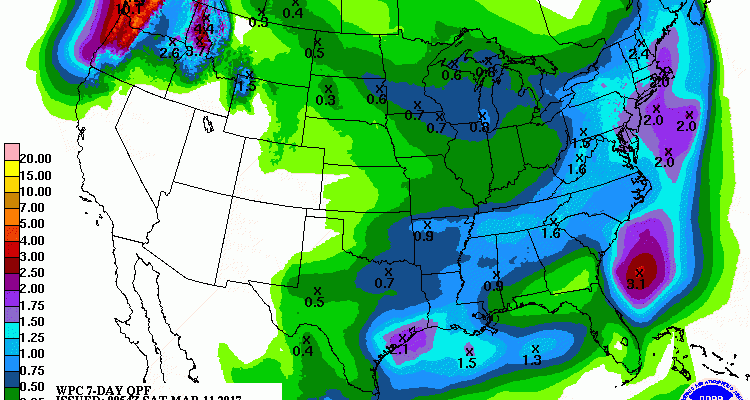March 2017
-

While here in the Southeast we have been experiencing an extremely warm winter, in the Pacific Northwest they are experiencing one of the coldest and wettest winters in at least 30 years. For younger folk born after 1985, it is the coldest winter they have ever experienced. Cliff Mass has produced a blog post which…
-

Here are some detailed global images of vegetation health, including several drought indices, fire danger and soil saturation maps as derived from the Suomi-NPP satellite. In addition to global maps you can view each variable by country. The detail is amazing! You can find out more about them at Climate.gov at https://www.climate.gov/maps-data/dataset/global-vegetation-health-images or go directly to…
-

The latest 7-day QPF shows a moderate amount of rain falling in northern areas of the region, with little to no rain occurring in southern Georgia and Alabama and most of Florida. More rain will fall off the coasts, but will not necessarily affect inland areas. From a timing standpoint, some precipitation is likely to…
Posted in: Climate outlooks -

Even though most people are watching colder temperatures and a slight possibility for wintry precipitation this weekend, especially in the northern mountainous areas, I think the real concern this week is going to be the potential for a hard freeze mid-week across a lot of the Southeast north of the Georgia-Florida border. This could be…
-

A number of wildfires in Texas, Oklahoma and Kansas have caused significant loss of livestock as well as killing several ranchers in Texas, according to reports in Drovers Newsletter this week. According to Reuters, “fast-moving wildfires that burned through nearly 2 million acres (809,380 hectares) of Texas, Oklahoma and Kansas this week have devastated ranches…
-

The Packer published a story yesterday on the growth of the production of Florida peaches. The article notes that “With virtually no other peaches on the market for an eight- to 10-week period each spring, Florida’s peach crop is establishing a place for itself in the market.” The story goes on to quote a grower…
-

For about 400 years centered around 1200 AD, Viking farmers lived in two colonies in Greenland, growing a few crops and raising herds of cattle and sheep. As many as 2500 Vikings may have inhabited the two colonies before they disappeared. Conventional wisdom says that they died out as the climate got colder after the end…